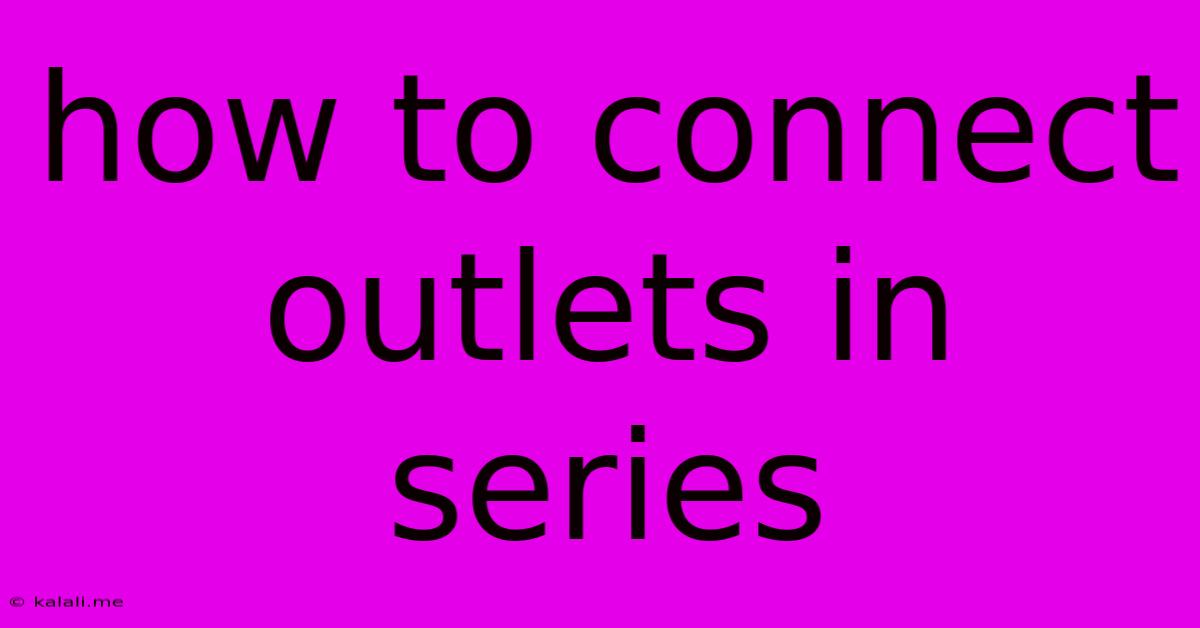How To Connect Outlets In Series
Kalali
Jun 07, 2025 · 3 min read

Table of Contents
How to Connect Outlets in Series: A Comprehensive Guide (with Safety Precautions)
Meta Description: Learn how to wire outlets in series safely and correctly. This comprehensive guide explains the process, including necessary tools, wiring diagrams, and crucial safety precautions. Avoid common mistakes and ensure a properly functioning electrical system.
Connecting outlets in series, while possible, is generally not recommended for most household applications. Unlike connecting them in parallel (the standard method), series wiring means that electricity flows through one outlet before reaching the next. This can lead to several problems, including inconsistent voltage and potential safety hazards. However, understanding how it's done is important for troubleshooting and specialized situations. This guide will explain the process, but strongly emphasizes the importance of professional electrical work for any significant home wiring projects.
Understanding Series and Parallel Wiring
Before diving into the process, it's crucial to understand the difference between series and parallel circuits.
- Parallel Wiring: In a parallel circuit (standard in homes), each outlet receives the full voltage from the power source. If one outlet fails, the others remain unaffected. This is the safest and most efficient way to wire outlets.
- Series Wiring: In a series circuit, the current flows through each outlet sequentially. The voltage is divided across the outlets, meaning each outlet receives a lower voltage than the source. If one outlet fails, the entire circuit is broken, and all outlets downstream will stop working.
Why Series Wiring is Generally Not Recommended for Outlets
- Voltage Drop: The biggest issue is the voltage drop across each outlet. This can lead to inconsistent performance of appliances and electronics plugged into the outlets.
- Single Point of Failure: A failure in any part of the series circuit will disable the entire circuit.
- Safety Concerns: Lower voltage at each outlet might not provide sufficient power for some devices, potentially leading to overheating or malfunction. Improper wiring can significantly increase the risk of electrical shocks and fires.
When Series Wiring Might Be Considered (with EXTREME caution)
There are very limited scenarios where series wiring might be considered, but only by experienced electricians:
- Very Low-Power Applications: In specialized low-power applications where voltage drop is minimal and the risk of failure is low, series wiring might be used. This is unlikely to be a residential application.
- Troubleshooting: An electrician might temporarily use series wiring during troubleshooting to isolate a problem within a circuit.
The Process (for Educational Purposes Only – Do Not Attempt Without Proper Training)
Disclaimer: The following is for educational purposes only. Attempting to wire outlets in series without proper electrical training and licensing is extremely dangerous and could result in serious injury or death. Always consult with a qualified electrician for any electrical work in your home.
If you were to connect outlets in series (again, strongly discouraged), you would connect the hot wire from the power source to the hot terminal of the first outlet. Then, the hot wire from the first outlet would connect to the hot terminal of the second outlet, and so on. The neutral wires would be connected in a similar series fashion. This creates a single path for the electricity to flow.
Tools Required (for a qualified electrician):
- Voltage tester
- Wire strippers
- Wire connectors
- Electrical tape
- Screwdrivers
Safety Precautions (Absolutely Critical)
- Turn off the power: Always turn off the power at the breaker box before working with any electrical wiring.
- Use appropriate safety equipment: Wear safety glasses and insulated gloves.
- Double-check your work: Carefully inspect all connections before turning the power back on.
- Consult a professional: If you are not a qualified electrician, do not attempt this. Hire a professional to do any electrical work in your home.
In Conclusion: While understanding the principles of series wiring is valuable, it's crucial to remember that connecting outlets this way in a home is unsafe and inefficient. Always prioritize safety and hire a qualified electrician for any electrical work. This guide serves only as an educational resource and should not be interpreted as instructions for home wiring projects.
Latest Posts
Latest Posts
-
Which Experiment Deduced Charge On Electron
Jun 07, 2025
-
Why Didnt A Itachikill His Own Clan
Jun 07, 2025
-
Can I Use Dot 4 Instead Of Dot 3
Jun 07, 2025
-
Freezer Stopped Working But Refrigerator Works
Jun 07, 2025
-
Are Imported Goods Included In Gdp
Jun 07, 2025
Related Post
Thank you for visiting our website which covers about How To Connect Outlets In Series . We hope the information provided has been useful to you. Feel free to contact us if you have any questions or need further assistance. See you next time and don't miss to bookmark.